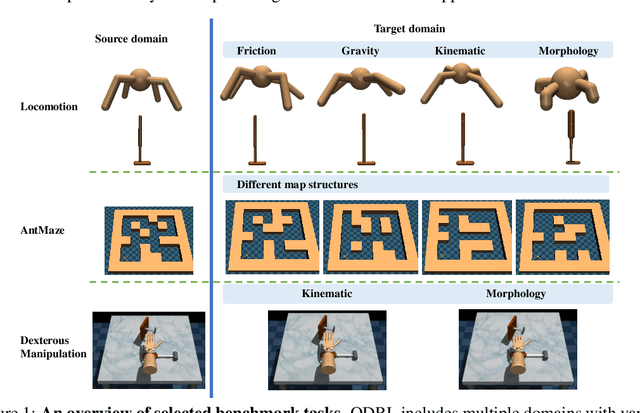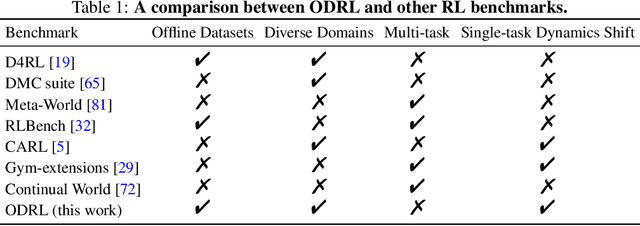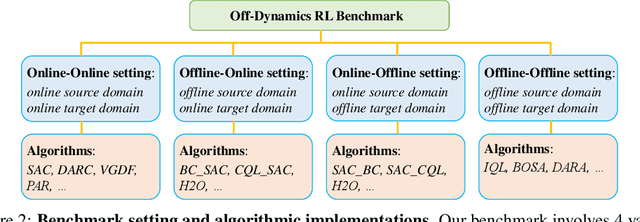Zongqing Lu
Being-0: A Humanoid Robotic Agent with Vision-Language Models and Modular Skills
Mar 16, 2025Abstract:Building autonomous robotic agents capable of achieving human-level performance in real-world embodied tasks is an ultimate goal in humanoid robot research. Recent advances have made significant progress in high-level cognition with Foundation Models (FMs) and low-level skill development for humanoid robots. However, directly combining these components often results in poor robustness and efficiency due to compounding errors in long-horizon tasks and the varied latency of different modules. We introduce Being-0, a hierarchical agent framework that integrates an FM with a modular skill library. The FM handles high-level cognitive tasks such as instruction understanding, task planning, and reasoning, while the skill library provides stable locomotion and dexterous manipulation for low-level control. To bridge the gap between these levels, we propose a novel Connector module, powered by a lightweight vision-language model (VLM). The Connector enhances the FM's embodied capabilities by translating language-based plans into actionable skill commands and dynamically coordinating locomotion and manipulation to improve task success. With all components, except the FM, deployable on low-cost onboard computation devices, Being-0 achieves efficient, real-time performance on a full-sized humanoid robot equipped with dexterous hands and active vision. Extensive experiments in large indoor environments demonstrate Being-0's effectiveness in solving complex, long-horizon tasks that require challenging navigation and manipulation subtasks. For further details and videos, visit https://beingbeyond.github.io/being-0.
GTR: Guided Thought Reinforcement Prevents Thought Collapse in RL-based VLM Agent Training
Mar 11, 2025Abstract:Reinforcement learning with verifiable outcome rewards (RLVR) has effectively scaled up chain-of-thought (CoT) reasoning in large language models (LLMs). Yet, its efficacy in training vision-language model (VLM) agents for goal-directed action reasoning in visual environments is less established. This work investigates this problem through extensive experiments on complex card games, such as 24 points, and embodied tasks from ALFWorld. We find that when rewards are based solely on action outcomes, RL fails to incentivize CoT reasoning in VLMs, instead leading to a phenomenon we termed thought collapse, characterized by a rapid loss of diversity in the agent's thoughts, state-irrelevant and incomplete reasoning, and subsequent invalid actions, resulting in negative rewards. To counteract thought collapse, we highlight the necessity of process guidance and propose an automated corrector that evaluates and refines the agent's reasoning at each RL step. This simple and scalable GTR (Guided Thought Reinforcement) framework trains reasoning and action simultaneously without the need for dense, per-step human labeling. Our experiments demonstrate that GTR significantly enhances the performance and generalization of the LLaVA-7b model across various visual environments, achieving 3-5 times higher task success rates compared to SoTA models with notably smaller model sizes.
Taking Notes Brings Focus? Towards Multi-Turn Multimodal Dialogue Learning
Mar 10, 2025Abstract:Multimodal large language models (MLLMs), built on large-scale pre-trained vision towers and language models, have shown great capabilities in multimodal understanding. However, most existing MLLMs are trained on single-turn vision question-answering tasks, which do not accurately reflect real-world human conversations. In this paper, we introduce MMDiag, a multi-turn multimodal dialogue dataset. This dataset is collaboratively generated through deliberately designed rules and GPT assistance, featuring strong correlations between questions, between questions and images, and among different image regions; thus aligning more closely with real-world scenarios. MMDiag serves as a strong benchmark for multi-turn multimodal dialogue learning and brings more challenges to the grounding and reasoning capabilities of MLLMs. Further, inspired by human vision processing, we present DiagNote, an MLLM equipped with multimodal grounding and reasoning capabilities. DiagNote consists of two modules (Deliberate and Gaze) interacting with each other to perform Chain-of-Thought and annotations respectively, throughout multi-turn dialogues. We empirically demonstrate the advantages of DiagNote in both grounding and jointly processing and reasoning with vision and language information over existing MLLMs.
CORD: Generalizable Cooperation via Role Diversity
Jan 04, 2025



Abstract:Cooperative multi-agent reinforcement learning (MARL) aims to develop agents that can collaborate effectively. However, most cooperative MARL methods overfit training agents, making learned policies not generalize well to unseen collaborators, which is a critical issue for real-world deployment. Some methods attempt to address the generalization problem but require prior knowledge or predefined policies of new teammates, limiting real-world applications. To this end, we propose a hierarchical MARL approach to enable generalizable cooperation via role diversity, namely CORD. CORD's high-level controller assigns roles to low-level agents by maximizing the role entropy with constraints. We show this constrained objective can be decomposed into causal influence in role that enables reasonable role assignment, and role heterogeneity that yields coherent, non-redundant role clusters. Evaluated on a variety of cooperative multi-agent tasks, CORD achieves better performance than baselines, especially in generalization tests. Ablation studies further demonstrate the efficacy of the constrained objective in generalizable cooperation.
Beyond Outcomes: Transparent Assessment of LLM Reasoning in Games
Dec 18, 2024



Abstract:Large Language Models (LLMs) are increasingly deployed in real-world applications that demand complex reasoning. To track progress, robust benchmarks are required to evaluate their capabilities beyond superficial pattern recognition. However, current LLM reasoning benchmarks often face challenges such as insufficient interpretability, performance saturation or data contamination. To address these challenges, we introduce GAMEBoT, a gaming arena designed for rigorous and transparent assessment of LLM reasoning capabilities. GAMEBoT decomposes complex reasoning in games into predefined modular subproblems. This decomposition allows us to design a suite of Chain-of-Thought (CoT) prompts that leverage domain knowledge to guide LLMs in addressing these subproblems before action selection. Furthermore, we develop a suite of rule-based algorithms to generate ground truth for these subproblems, enabling rigorous validation of the LLMs' intermediate reasoning steps. This approach facilitates evaluation of both the quality of final actions and the accuracy of the underlying reasoning process. GAMEBoT also naturally alleviates the risk of data contamination through dynamic games and head-to-head LLM competitions. We benchmark 17 prominent LLMs across eight games, encompassing various strategic abilities and game characteristics. Our results suggest that GAMEBoT presents a significant challenge, even when LLMs are provided with detailed CoT prompts. Project page: \url{https://visual-ai.github.io/gamebot}
AuctionNet: A Novel Benchmark for Decision-Making in Large-Scale Games
Dec 14, 2024Abstract:Decision-making in large-scale games is an essential research area in artificial intelligence (AI) with significant real-world impact. However, the limited access to realistic large-scale game environments has hindered research progress in this area. In this paper, we present \textbf{AuctionNet}, a benchmark for bid decision-making in large-scale ad auctions derived from a real-world online advertising platform. AuctionNet is composed of three parts: an ad auction environment, a pre-generated dataset based on the environment, and performance evaluations of several baseline bid decision-making algorithms. More specifically, the environment effectively replicates the integrity and complexity of real-world ad auctions through the interaction of several modules: the ad opportunity generation module employs deep generative models to bridge the gap between simulated and real-world data while mitigating the risk of sensitive data exposure; the bidding module implements diverse auto-bidding agents trained with different decision-making algorithms; and the auction module is anchored in the classic Generalized Second Price (GSP) auction but also allows for customization of auction mechanisms as needed. To facilitate research and provide insights into the game environment, we have also pre-generated a substantial dataset based on the environment. The dataset contains trajectories involving 48 diverse agents competing with each other, totaling over 500 million records and occupying 80GB of storage. Performance evaluations of baseline algorithms such as linear programming, reinforcement learning, and generative models for bid decision-making are also presented as part of AuctionNet. We note that AuctionNet is applicable not only to research on bid decision-making algorithms in ad auctions but also to the general area of decision-making in large-scale games.
VideoOrion: Tokenizing Object Dynamics in Videos
Nov 25, 2024Abstract:We present VideoOrion, a Video Large Language Model (Video-LLM) that explicitly captures the key semantic information in videos--the spatial-temporal dynamics of objects throughout the videos. VideoOrion employs expert vision models to extract object dynamics through a detect-segment-track pipeline, encoding them into a set of object tokens by aggregating spatial-temporal object features. Our method addresses the persistent challenge in Video-LLMs of efficiently compressing high-dimensional video data into semantic tokens that are comprehensible to LLMs. Compared to prior methods which resort to downsampling the original video or aggregating visual tokens using resamplers, leading to information loss and entangled semantics, VideoOrion not only offers a more natural and efficient way to derive compact, disentangled semantic representations but also enables explicit object modeling of video content with minimal computational cost. Moreover, the introduced object tokens naturally allow VideoOrion to accomplish video-based referring tasks. Experimental results show that VideoOrion can learn to make good use of the object tokens, and achieves competitive results on both general video question answering and video-based referring benchmarks.
Pre-trained Visual Dynamics Representations for Efficient Policy Learning
Nov 05, 2024Abstract:Pre-training for Reinforcement Learning (RL) with purely video data is a valuable yet challenging problem. Although in-the-wild videos are readily available and inhere a vast amount of prior world knowledge, the absence of action annotations and the common domain gap with downstream tasks hinder utilizing videos for RL pre-training. To address the challenge of pre-training with videos, we propose Pre-trained Visual Dynamics Representations (PVDR) to bridge the domain gap between videos and downstream tasks for efficient policy learning. By adopting video prediction as a pre-training task, we use a Transformer-based Conditional Variational Autoencoder (CVAE) to learn visual dynamics representations. The pre-trained visual dynamics representations capture the visual dynamics prior knowledge in the videos. This abstract prior knowledge can be readily adapted to downstream tasks and aligned with executable actions through online adaptation. We conduct experiments on a series of robotics visual control tasks and verify that PVDR is an effective form for pre-training with videos to promote policy learning.
ODRL: A Benchmark for Off-Dynamics Reinforcement Learning
Oct 28, 2024



Abstract:We consider off-dynamics reinforcement learning (RL) where one needs to transfer policies across different domains with dynamics mismatch. Despite the focus on developing dynamics-aware algorithms, this field is hindered due to the lack of a standard benchmark. To bridge this gap, we introduce ODRL, the first benchmark tailored for evaluating off-dynamics RL methods. ODRL contains four experimental settings where the source and target domains can be either online or offline, and provides diverse tasks and a broad spectrum of dynamics shifts, making it a reliable platform to comprehensively evaluate the agent's adaptation ability to the target domain. Furthermore, ODRL includes recent off-dynamics RL algorithms in a unified framework and introduces some extra baselines for different settings, all implemented in a single-file manner. To unpack the true adaptation capability of existing methods, we conduct extensive benchmarking experiments, which show that no method has universal advantages across varied dynamics shifts. We hope this benchmark can serve as a cornerstone for future research endeavors. Our code is publicly available at https://github.com/OffDynamicsRL/off-dynamics-rl.
Quo Vadis, Motion Generation? From Large Language Models to Large Motion Models
Oct 04, 2024Abstract:Inspired by the recent success of LLMs, the field of human motion understanding has increasingly shifted towards the development of large motion models. Despite some progress, current state-of-the-art works remain far from achieving truly generalist models, largely due to the lack of large-scale, high-quality motion data. To address this, we present MotionBase, the first million-level motion generation benchmark, offering 15 times the data volume of the previous largest dataset, and featuring multimodal data with hierarchically detailed text descriptions. By leveraging this vast dataset, our large motion model demonstrates strong performance across a broad range of motions, including unseen ones. Through systematic investigation, we underscore the importance of scaling both data and model size, with synthetic data and pseudo labels playing a crucial role in mitigating data acquisition costs. Moreover, our research reveals the limitations of existing evaluation metrics, particularly in handling out-of-domain text instructions -- an issue that has long been overlooked. In addition to these, we introduce a novel 2D lookup-free approach for motion tokenization, which preserves motion information and expands codebook capacity, further enhancing the representative ability of large motion models. The release of MotionBase and the insights gained from this study are expected to pave the way for the development of more powerful and versatile motion generation models.
 Add to Chrome
Add to Chrome Add to Firefox
Add to Firefox Add to Edge
Add to Edge